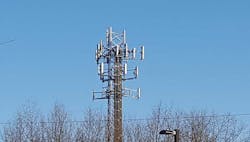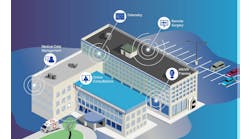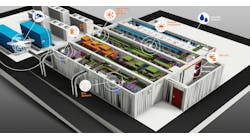5G wireless is coming, and when it arrives, it will bring faster and denser streams of data, a trend that is likely to drive demand for more data center capacity. What will this flood of data look like, and when will it arrive?
The 5G transition has taken center stage in the data center world in recent weeks, featuring in keynotes at industry conferences, blog items from Equinix and Digital Realty, and a new report from Cisco. Analysts differ on the timing and breadth of 5G’s adoption, and the forecast is clouded by hype and marketing.
The bottom line: It appears likely that 5G will begin to generate noticeable business for data centers in late 2019, as service providers and hyperscale operators begin to deploy next-generation networking equipment to prepare for the onset of 5G services in 2020 and beyond, with the trickle of data growing into a digital tsunami by 2022.
“I think 5G will be a big enabler for data centers,” said Sami Badri, a securities analyst at Credit Suisse. “Interconnection players will benefit from 5G. Don’t be surprised if you hear 5G is the major driver for new business at places like Equinix, Digital Realty and CoreSite.
“We’re in the very first inning of this transition,” Badri said in a presentation Jan. 31 at the CAPRE 2019 Data Center Forecast in Ashburn, Va. A useful leading indicator of 5G adoption is the progress of network equipment vendors, said Badri, who highlighted Arista Networks as a bellwether for 400 Gbps switches that will dramatically boost network capacity. “Engineering foreshadows demand,” he said.
Why 5G Wireless Matters
5G wireless is the next-generation mobile protocol, which is expected to enable new data-intensive services like autonomous vehicles, which are untenable with current wireless connectivity. If 5G succeeds, it will be easier to move data between locations, a trend that has always been good for the data center business. 5G technology is expected to have three key attributes:
- High-bandwidth mobile broadband of 100 Mbps or better
- Support for massive machine-to-machine (M2M) communications, with density of up to 100,000 connections per square kilometer.
- Ultra low-latency communications, enabling sub-10 millisecond latency for mission-critical apps.
5G will be deployed over a number of years, spreading as new equipment is finalized. It will require new transmission infrastructure, including thousands of cell towers and tens of thousands of antenna – known as small cells and DAS (distributed antenna systems) – that will be deployed on utility poles and other urban infrastructure. It will also need fiber – LOTS of fiber.
The history of wireless technology transitions. (Graphic: Digital Realty)
The 5G transition will bring many benefits and many challenges, according to Kelvin Cheung, Principal Global Solutions Architect at Equinix.
“Faster, lower-latency 5G network infrastructures will be a huge boost to IoT, AI, online gaming, virtual/augmented reality, and smart cities,” Cheung writes on the Interconnections blog. “But before any of this can see the light of day, many regulatory, spectrum licensing, security and infrastructure retrofitting issues that currently exist must be resolved on a country-by-country basis.”
5G Kickoff in South Korea
The earliest deployments will take place in South Korea, a nation known for its advanced broadband infrastructure. That’s why Equinix has just opened its first data center in Seoul, which will open in the third quarter of this year. Korea Telecom, LG UPlus, and SK Telecom have all switched on 5G-capable infrastructure in late 2018, and Samsung is showcasing its 5G technology at this week’s Mobile World Congress in Barcelona.
The South Korean deployment is the first step towards a new paradigm in wireless communications, according to Cisco Systems, which today shared new predictions for how 5G will boost mobile data growth.
“By 2022, we believe 5G’s initial impact will be measurable and significant,” Cisco concludes in its latest Mobile Visual Networking Index, which projects that the average smartphone will generate 11 Gb of mobile traffic per month in 2022, compared to 2 GB per month in 2017. This will bring us to the verge of what Cisco calls the “mobile zettabyte era.”
Projections on wireless data growth from Cisco’s Mobile Visual Networking Index. (Image: Cisco Systems)
“While these projections are impressive, the full value and transformational capabilities of 5G cannot simply be measured by performance improvements over 4G (higher bandwidth, broader coverage, and lower latency),” writes Thomas Barnett Jr., Cisco’s Director of Service Provider Thought Leadership. “5G will also deliver enhanced power efficiency, cost optimization, massive IoT connection density and dynamic allocation of resources based on awareness of content, user, and location. 5G will be able to concurrently support both low-end IoT applications (such as sensors and meters) as well as high-end IoT applications (such as autonomous driving cars and tactile Internet experiences).”
Cisco projects that the average smartphone will generate 11 Gb of mobile traffic per month in 2022, compared to 2 GB per month in 2017.
Data centers will be key components of the infrastructure to make all this happen, according to Nadia Tuffaha, Senior Content Manager at Digital Realty.
“In order to successfully create a completely seamless and invisible network that wirelessly connects all devices and interactions with those devices, data will need to be transferred, stored, and processed at rapid speeds that are not just fast but also consistent and highly reliable,” Tuffaha writes in a blog post on the Evolution of 5G and Impact on Data Center Infrastructure.
“On the back-end certain data will need to live on a dedicated network away from congestion from other applications,” she writes. “While entertainment companies can’t afford to compromise user experience, trust and loyalty with inconsistent and slow network speed, regulations will need to be implemented that place higher importance on applications that affect one’s health and/or safety.”
The 5G Equation for Data Centers
This rising tide of data will have broad business benefit for the IT infrastructure industry. But not all data centers will see an equivalent benefit, according to Badri of Credit Suisse. The primary beneficiaries of 5G data growth will be data centers with a focus on interconnection, which is why he sees gains for Equinix, Digital Realty and CoreSite.
Wholesale data center providers without that interconnection component will see a more limited benefit, Badri said. Software-defined networking (SDN) specialists like Megaport and Packet Fabric can help wholesale providers participate.
Badri says the 5G transition is driving a major shift to software-defined infrastructure, with mobile providers upgrading their infrastructure to support a “cloud-native” computing paradigm.
That’s why telecom companies have embraced the Open Compute Project (OCP) to deploy low-cost “white box” servers and switches running sophisticated SDN software. Analysts see an opportunity for OCP hardware to support uCPE (Universal Customer Premises Equipment), an initiative by major carriers to bring cloud technologies into the telecom ecosystem, including software-defined networking (SDN) and network functions virtualization (NFV).
“Telco will look just like cloud computing over time,” predicts Badri. “NFV is essentially the cloud paradigm being applied to everything.”
Analyst Sami Badri of Credit Suisse described how the development of 5G wireless services may impact data center growth in 2019 and 2020. (Photo: Rich Miller)
That’s why Equinix believes NFV and virtual network applications can unlock a $15 billion market for hardware, software and services by 2020. The company hasn’t yet rolled out public NFV offerings, but is working with early adopter customers. That would mark the next step in Equinix goal to gradually infuse the company’s entire global platform with SDN capabilities, offering customers “one connection to the world.”
5G and Edge Computing
5G wireless infrastructure will be the “tip of the spear” for edge computing infrastructure to follow. Thus, the geography of the 5G networks and associated business revenue will guide much of the early investment. An ecosystem of modular data center operators has emerged to pursue edge infrastructure buildouts, including companies like Vapor IO, EdgeConneX, EdgeMicro, DartPoints, DataBank, Baselayer and Switch.
“There will always be a need for a centralized core as the beating heart to any IT environment.” – Digital Realty
But the industry’s two largest players also see opportunity in 5G-driven edge deployments.
“One critical barrier to overcome is the distance limitations inherent in 5G technology that will require proximate placement and interconnection between larger numbers of 5G network nodes,” says Cheung of Equinix. “Service providers and enterprises will need to look at distributed IT and network infrastructures that place 5G at the digital edge – close to commerce, population centers and digital ecosystems of network and cloud service providers. Proximity to a variety of 5G NSPs in regional metros gives small-to-medium service providers and enterprises the ability to lease 5G networks as a service. This provides companies that may not have the resources to make the transition to 5G themselves access to larger 5G NSPs[iv] via local high-speed, low-latency connections.”
“We’re starting to see more emphasis on localized, distributed computing power to support mission-critical applications with lower latency and higher resiliency,” writes Tuffaha at Digital Realty. “However, there will always be a need for a centralized core as the beating heart to any IT environment. After all, even the most advanced micro data centers will not be capable of handling all tasks exclusively at the edge.”






